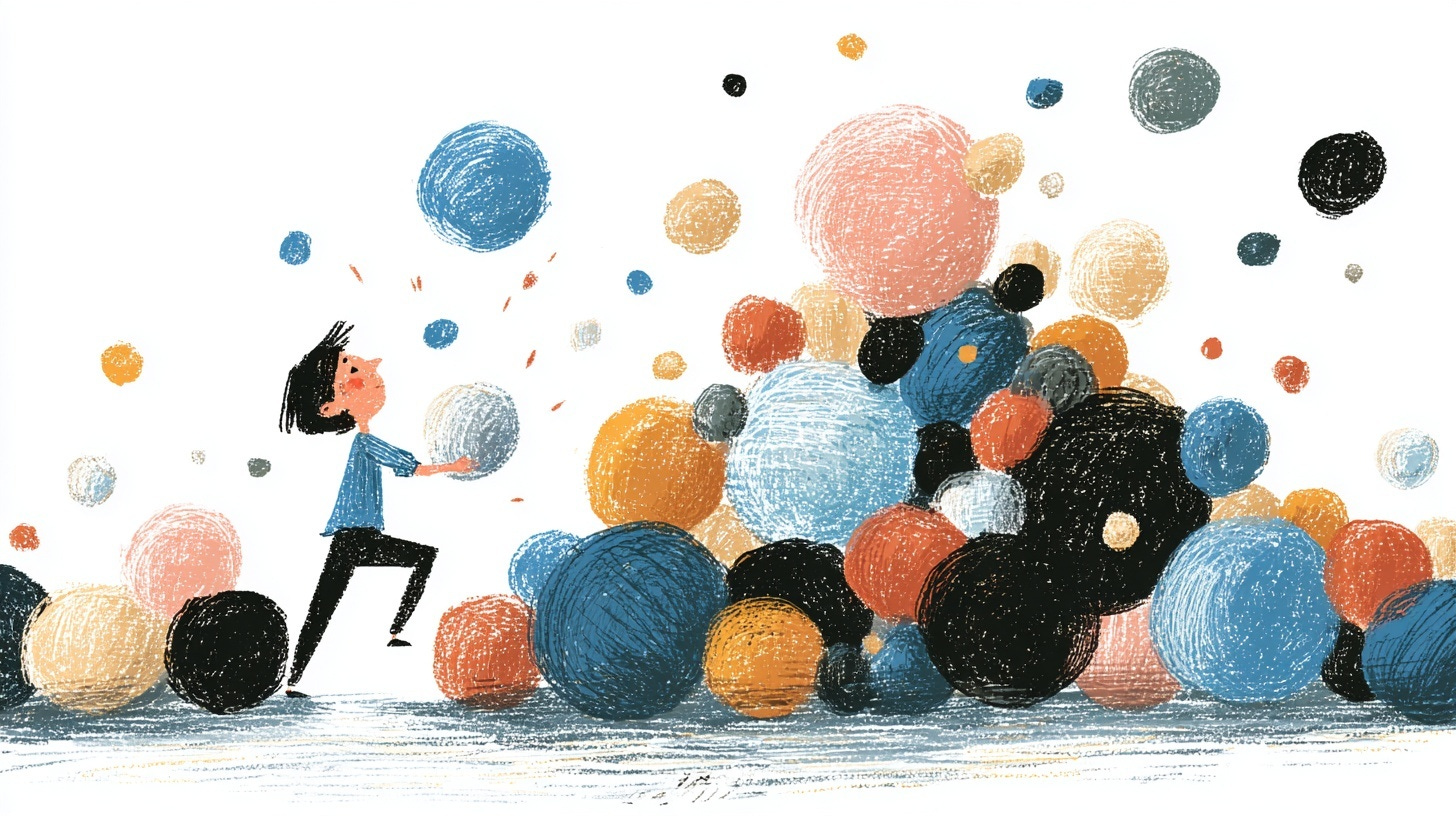The AI feedback loop: When design systems train the models that critique them
AI is learning from our design systems, and quietly reshaping them in return. Here’s what that feedback loop means for consistency, drift, and control
There’s a strange circularity happening in design systems right now. AI learns from our design systems, generates new designs based on those patterns, and those AI-generated designs feed back into the next iteration of the system. Round and round it goes.
I’m already seeing it in my social circles: AI tools that generate “on-brand” layouts by default, and systems quietly drifting to match whatever the model thinks looks right.
On the surface, this seems efficient. AI tools are learning from real-world component structures, understanding our design tokens, and generating code that matches our patterns. The promise is productivity – less grunt work, faster iteration, more time for strategic thinking.
But there’s a darker possibility lurking beneath: what happens when systems start converging toward AI-learned patterns rather than human-designed principles? When the distinction between intentional design decisions and what AI thinks looks “correct” starts to blur?
We’re sleepwalking into a design monoculture, and the stakes are higher than we think.
Before I go further: I’m not arguing that we should abandon AI tools. I use them daily, and when they work well, they’re genuinely useful. But that’s precisely why it’s worth understanding the risks. The teams getting the most value from AI are the ones who understand its failure modes, not the ones pretending they don’t exist.
How the loop actually works
AI models don’t just magically know how to generate good design. They learn from existing work, including your design system. Tools with acccess to Figma files through APIs can parse component metadata, auto-layout constraints, layer names, token assignments, and hierarchy. They see how you’ve structured things, what naming conventions you use, which patterns repeat.
This is powerful. Instead of hallucinating code from flat images, AI can understand the sematnic meaning behind your components. It knows that a button with specific properties and token references probably represents a primary action. It can infer layout logic and preserve the relationship betweeen elements.
If your design file is inconsistent – detached components here, raw hex values there, missing tokens everywhere – that’s exactly what the AI sees. It doesn’t pause and think “hmm, this looks messy, I should probably check with a human”. It tries to fill in the blanks, making educated guesses based on whatever patterns it can find. Sometimes those guesses are close enough. Other times, they drift just far enough to break your intended logic.
Every subtle drift becomes another deviation to maintain, another fork in the system that chips away at consistency. Research on model collapse shows that when models keep training on their own outputs, they don’t just get a bit worse, they systematically squeeze out the rare, informative signals that keep them grounded in reality.
The convergence problem
When enough teams use similar AI tools trained on similar datasets, something predictable happens: designs start to look the same. Not because teams are copying each other, but because they’re all being nudged toward the same statistical averages that the AI learned from its training data.
You’ve probably seen this already. Ask most AI tooling to scaffold a web application and you’ll get React with Tailwind CSS and Shadcn-style components. Not because these are necessarily the best choices for your specific context, but because they’re the most common patterns in the training data. Over time, that default stack starts to feel inevitable.
The same thing is starting to happen with design systems. The same fonts appearing everywhere. Similar colour palettes. Rounded corners that all feel like they came from the same template. Designs that quietly signal they’ve been AI-generated. This isn’t intentional – it’s just what happens when LLMs train on the internet and naturally drift toward the most common patterns. The result is everything starts looking generic, safe, and forgettable.
Even when these AI tools produce decent results for individual teams, everyone using the same tools can make the overall ecosystem worse. Your button might look fine. But when every team’s buttons start converging toward the same AI-averaged pattern, we lose the diversity that makes good design resilient.
When AI eats its own outputs
There’s another, more insidious problem: model collapse. This happens when AI models are trained on their own outputs, repeatedly, until they lose grip on the statistical diversity that made them useful in the first place.
A 2024 Nature paper by Ilia Shumailov and colleagues showed that when generative models are repeatedly trained on their own outputs, they undergo “model collapse”: the rich, long-tail parts of the original data distribution disappear, and the model’s behaviour narrows and degrades over time.
In other words, the feedback loop of models training on model-generated data doesn’t just make them a bit worse – it steadily erases the edge cases and rare patterns that made them useful in the first place.
Now imagine this happening with design systems. AI generates a button component based on your existing system. That component gets used in production. The AI sees this new pattern in the wild, learns from it, and generates more buttons that look similar. Those buttons get used. The AI learns from those. And so on.
Each iteration pulls the system a bit closer to whatever the AI thinks a button should look like, based on aggregated patterns. The human decisions that made your button distinctive – the specific padding that feels right for your brand, the particular shade of blue that tests well with your users, the subtle animation that delights without distracting – all of that gets smoothed away by the averaging effect of repeated AI generations.
In design-system terms, model collapse looks like every new generation flattening your patterns into whatever’s “most average” in the training mix.
Fan Wu, Emily Black, and Varun Chandrasekaran use the term “generative monoculture” to describe this phenomenon in large language models: a significant narrowing of model output diversity relative to the available training data. They argue that a lot of the root causes are embedded within the way we align models – the processes we use to make outputs more consistent and “safe”.
Preserving diversity isn’t just a tuning problem; it may require rethinking how we fine-tune models in the first place.
The challenge of preserving intent
How do you preserve intentional design decisions when AI keeps trying to “correct” what it sees as inconsistencies?
Let’s say you’ve deliberately chosen to use a non-standard button size in a specific context because user testing showed it performed better. The AI doesn’t know this. It sees a button that doesn’t match the pattern it learned from thousands of other buttons, so it helpfully “fixes” it to match the standard size. Your intentional decision becomes a bug in the AI’s eyes.
I saw this play out recently on a project where we’d deliberately broken our own grid in a financial dashboard to give one cashflow metric more visual weight. The first AI-generated iteration snapped everything back into a perfect grid – it “fixed” our exception and, in the process, flattened the whole point of the screen.
Design systems encode more than just visual patterns. They encode intent, context, and judgement. They represent hundreds of discussions about trade-offs, countless rounds of user testing, hard-won insights about what works for your specific audience. When AI trains on the outputs without understanding the inputs – the reasoning, the constraints, the goals – it can replicate the form while missing the function entirely.
A design system isn’t a snapshot. It’s a continuous conversation about what works, what doesn’t, and why. It’s documentation that gets updated, components that get deprecated, patterns that evolve based on real-world feedback. Strip away that living, breathing quality and you’re left with a fossil – something that looks like a design system but has none of the adaptive capacity that makes it useful.
Breaking the loop
So what do we do? Abandon AI tools and go back to doing everything manually? That’s not realistic, and it’s not the answer.
The solution isn’t to avoid AI. It’s to be intentional about how we integrate it into our workflows. Here’s what that looks like in practice:
Document your intent, not just your patterns
AI can see that you’ve used a specific button size, but it can’t know why unless you tell it. Add comments, notes, and documentation that explain the reasoning behind decisions. Make your design system legible not just in what it shows, but in what it says.
Build feedback mechanisms that preserve diversity
When AI generates a component, don’t just accept it at face value. Review it against your principles. Ask: does this maintain what makes our system distinctive? Or has it been pulled toward generic patterns? Create checkpoints where human judgement can intervene before AI-generated patterns become part of the system.
Mix your training data
If you’re fine-tuning AI models on your design system, make sure you’re not just feeding them their own outputs. Include diverse examples, edge cases, and exceptions. Early work on mitigating collapse suggests that strategies like capping how much synthetic data you use, filtering it aggressively, or mixing it carefully with human-created data can reduce the risk – but they don’t remove it entirely.
Monitor for convergence
Track whether your design system is becoming more or less diverse over time. Are you introducing new patterns or just reinforcing existing ones? Are components becoming more similar to each other? Set up metrics that can detect when things are drifting toward monoculture.
Rotate your AI tools
Don’t rely on a single AI model for all your generation tasks. Different models have different training data and different biases. Using multiple tools helps prevent the convergence that comes from everyone using the same algorithm.
Inject creative constraints
Use brand-specific guidelines, forbidden patterns, and explicit rules that force AI to work within your unique parameters rather than falling back on common patterns. Make it harder for the AI to generate generic solutions.
The irony is that the more we automate, the more we need solid foundations. AI doesn’t make design systems less important – it makes them essential. Without clear principles and reusable patterns, automation just scales chaos faster. The systems that will thrive are the ones that treat AI as amplification, not replacement.
AI doesn’t make design systems less important. It makes their structure non-negotiable.
The monoculture risk is real
If we’re not careful, design systems could end up like agriculture in the mid-20th century: hyper-optimised for efficiency but dangerously fragile. Agricultural monocultures increase yield in good conditions, but are vulnerable to single points of failure. When a pest or disease finds a weakness in the crop, it spreads like wildfire because every plant is identical.
The same logic applies to design systems. If everyone’s using the same AI-generated patterns, what happens when those patterns have a flaw? When a usability issue emerges that impacts millions of interfaces simultaneously because they all converged on the same solution?
Diversity in design systems acts as a survival mechanism. Different approaches to the same problem provide insurance against correlated failures – when one solution doesn’t work, alternatives exist.
Research on generative monoculture in LLMs found that alignment processes – the techniques used to make AI outputs more consistent and “correct” – are precisely what narrows diversity. The better AI gets at producing what we think we want, the less variety we get overall.
The rise of “default” stacks like React and Tailwind has already sparked worries about a developer monoculture – a world where every frontend looks and feels the same, and it becomes harder to experiment at the edges. Design systems face the same risk: reduced competition leads to less innovation, new patterns struggle to gain adoption if AI tools don’t recognise them, and people new to the field may never explore alternative approaches.
Design systems as living products
The key insight here is that design systems aren’t static libraries – they’re living products that evolve through continuous human judgement. When we treat them as fixed patterns to be replicated by AI, we lose what makes them valuable.
AI doesn’t understand intent. It can’t weigh trade-offs. It can’t say “this breaks our normal pattern, but it’s the right call for this specific context”. That’s still the work of humans.
What AI can do is amplify the quality of the signals we give it. If your design system is disciplined, structured, and well-documented, AI makes it more powerful. If it’s inconsistent and ambiguous, AI makes that inconsistency impossible to ignore.
The most impressive AI-generated code doesn’t come from teams with groundbreaking prompts or detailed documentation. It comes from teams with disciplined design systems – the ones doing the unglamorous work of maintaining consistency, updating tokens, and keeping components aligned.
This is the paradox: AI tools work best when they’re working with human-created structure, not replacing it. The feedback loop becomes dangerous only when we abdicate the responsibility to maintain that structure in favour of letting AI fill in the gaps.
The path forward
We’re at a pivotal moment. The next few years will determine whether design systems become more diverse and robust, or whether they converge into a bland monoculture of AI-learned patterns.
The teams that will succeed are those who treat AI as a diagnostic tool, not a replacement for judgement. Use it to identify inconsistencies in your system. Let it generate variations that you can evaluate and refine. Allow it to handle repetitive work so you can focus on strategic decisions. But never let it make decisions about intent, context, or trade-offs.
Build systems that are explicit about their principles. Make your design decisions legible not just to other humans, but to machines. Create documentation that explains the why, not just the what. Establish governance processes that include checkpoints for human review before AI-generated patterns become canon.
Most importantly: resist convergence. When you see your design system starting to look like everyone else’s, ask why. Is it because you’ve arrived at genuinely better solutions through your own process, or is it because you’re being pulled toward common patterns by AI tools?
The value of a design system isn’t just in efficiency – it’s in encoding your organisation’s unique understanding of what works for your users, in your context, for your goals. Don’t let the averaging effect of AI smooth away what makes your system distinctive.
The AI feedback loop is real. The monoculture risk is real. But so is the opportunity to build systems that are stronger, clearer, and more intentional than ever before. The choice is ours, but only if we’re paying attention.
Thanks for reading! Subscribe for free to receive new posts directly in your inbox.
This article is also available on Medium, where I share more posts like this. If you’re active there, feel free to follow me for updates.
I’d love to stay connected – join the conversation on X and Bluesky, or connect with me on LinkedIn to talk design systems, digital products, and everything in between. If you found this useful, sharing it with your team or network would mean a lot.









